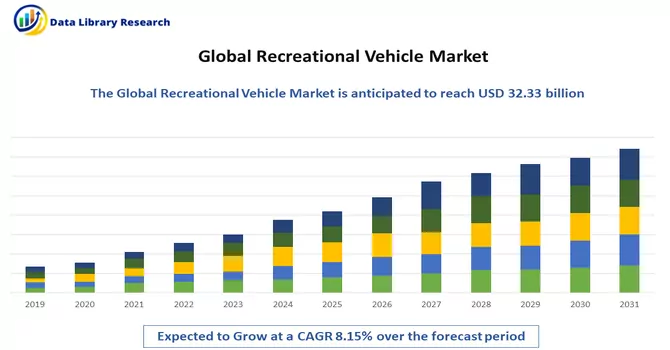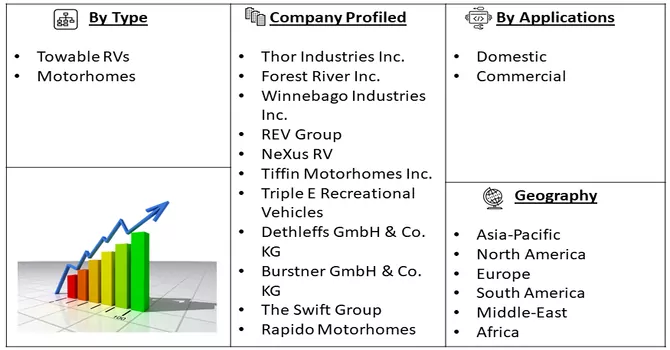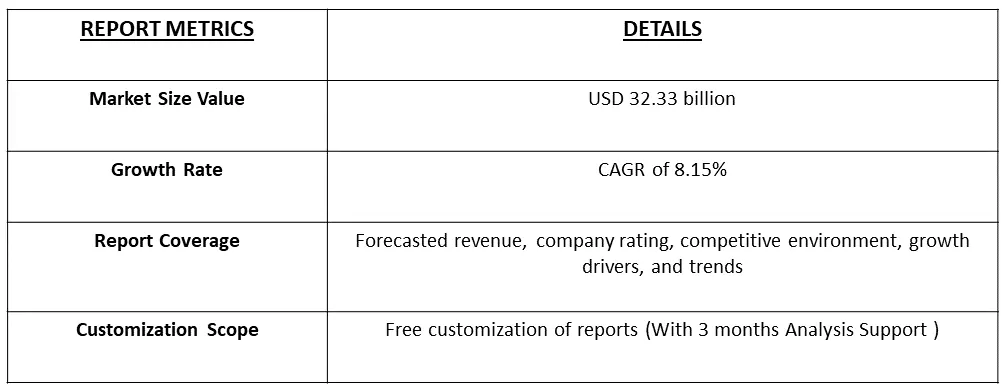The Recreational Vehicle Market size is expected to grow from USD 32.33 billion in 2022 and is expected to register a CAGR of 8.15% during the forecast period (2023-2031).

Get Complete Analysis Of The Report - Download Free Sample PDF
A Recreational Vehicle (RV) is a motorized or towable vehicle designed for temporary living quarters and recreational travel. RVs are equipped with amenities that provide both transportation and accommodation, allowing individuals or families to travel, camp, and explore various destinations with the convenience of a home on wheels. These versatile vehicles come in various types and sizes, offering a range of features and comforts to meet different preferences and travel needs.
The growing interest in outdoor and recreational activities, including camping, road trips, and nature exploration, fuels the demand for RVs. Consumers seek the freedom and flexibility that RVs offer in experiencing the outdoors. As disposable income levels increase, consumers are more inclined to invest in leisure and travel experiences. RVs provide a cost-effective and convenient way for individuals and families to embark on vacations and adventures.
Market Segmentation: The Global Recreational Vehicle (RV) Market is Segmented by Type (Towable RVs and Motorhomes), Towable RVs (Travel Trailers, Fifth-wheel Trailers, Folding Camp Trailers, and Truck Campers), Motorhomes (Type A, Type B, and Type C), Application (Domestic and Commercial), and Geography (North America, Europe, Asia Pacific, and Rest of the world). In addition, the report offers market size and forecast for the recreational vehicle market in value (USD billion) for all the above segments.

For Detailed Market Segmentation - Download Free Sample PDF
The popularity of RV rental and sharing platforms is growing. Peer-to-peer rental services and established platforms offer consumers the opportunity to experience RV travel without the long-term commitment of ownership. Moreover, there is a rising demand for luxury RVs equipped with high-end amenities, premium materials, and custom features. Consumers seeking a more upscale RV lifestyle are driving this trend.
Also, manufacturers are diversifying their RV product lines to cater to a broad range of consumer preferences. This includes innovative designs, multi-functional spaces, and models that appeal to different demographic segments.
Market Drivers :
Rising Consumer Interest in Outdoor and Adventure Travel
The increasing preference for outdoor and adventure travel is a significant catalyst driving the demand for recreational vehicles (RVs). Consumers are drawn to the allure of having the freedom to comfortably explore nature and diverse destinations. This desire for exploration and flexibility is a key factor propelling the widespread popularity of RV travel. The appeal of RVs lies in their ability to provide a unique and immersive experience, allowing individuals and families to embark on journeys where they can connect with nature and discover new destinations at their own pace. The sense of independence and the ability to navigate off-the-beaten-path locations contribute to the growing inclination towards RV travel experiences.
Furthermore, RVs offer a convenient and self-contained mode of travel, allowing adventurers to bring the comforts of home with them on the road. The ability to seamlessly transition between different environments, whether it be national parks, scenic coastlines, or mountainous terrains, enhances the overall appeal for those seeking an immersive and nature-centric travel lifestyle. Thus, such factors are expected to drive the growth of the studied market over the forecast period.
Changing Lifestyles and Preferences
The shifting dynamics of consumer lifestyles, marked by a growing inclination towards experiential travel and a preference for adaptable living arrangements, significantly enhance the attractiveness of recreational vehicles (RVs). This trend is driven by the contemporary consumer's desire for more immersive and personalized travel experiences, coupled with a flexible approach to their living arrangements. The appeal of RVs is deeply rooted in their capacity to provide a platform for experiential travel, allowing individuals and families to break away from conventional vacation norms. RV enthusiasts can tailor their journeys to align with personal preferences, choosing destinations that resonate with their interests and creating unique itineraries. This customization capability aligns seamlessly with the evolving preferences of modern consumers who seek more than standardized travel experiences. Moreover, RVs cater to the demand for flexible living arrangements, offering a dynamic and mobile lifestyle that can adapt to different environments and circumstances. This flexibility resonates with individuals who value the ability to curate their living spaces according to the changing demands of their journeys, whether it involves exploring nature reserves, coastal retreats, or urban landscapes. Thus, such factors are expected to drive the growth of the studied market over the forecast period.
Market Restraints :
Depreciation and Resale Value and Regulatory Compliance and Zoning Restrictions
RVs often experience rapid depreciation, impacting their resale value. The potential for significant depreciation can deter some potential buyers who are concerned about the long-term financial implications of RV ownership. Moreover, stringent regulations related to safety, emissions, and size restrictions may pose challenges for RV manufacturers in terms of compliance. Additionally, zoning restrictions in certain areas may limit where RVs can be parked or used, affecting their usability and convenience. Thus, such factors are expected to witness significant growth over the forecast period.
The global tourism industry experienced a significant setback due to the COVID-19 crisis, leading to a notable decline in recreational vehicle (RV) sales during the initial months of 2020. Despite this downturn, the market has exhibited a gradual recovery, with consumers showing a preference for staying in caravans over traditional hotels. This shift in consumer behaviour is anticipated to contribute to the growth of the RV market during the forecast period. The market's resurgence is further influenced by the increasing popularity of rental services in emerging economies. The widespread availability of RV rental options is expected to be a short-term driver for the market, providing consumers with flexible and alternative travel solutions. As the tourism landscape continues to evolve in response to changing preferences and travel patterns, the RV market is positioned for recovery and growth.
Segmental Analysis:
The towable RVs Segment is Expected to Witness Significant Growth Over the Forecast Period
Towable RVs, also known as travel trailers, are a popular and versatile category of recreational vehicles that can be towed by a motorized vehicle. They provide a flexible and convenient way for individuals and families to explore the outdoors without the need for a separate motorized unit. Towable RVs come in various styles and sizes, catering to different preferences and travel needs. Towable RVs often come at a lower upfront cost compared to motorized RVs, making them an attractive option for budget-conscious travellers. It's crucial to match the towable RV's weight to the towing capacity of the vehicle. This ensures safe and efficient towing. Thus, owing to such advantages, the segment is expected to witness significant growth over the forecast period.
Commercial Segment is Expected to Witness Significant Growth Over the Forecast Period
Commercial use of recreational vehicles (RVs) has evolved beyond traditional recreational and leisure activities. RVs are increasingly employed for various commercial purposes, leveraging their mobility, flexibility, and self-contained features. RVs, especially those designed as food trucks, serve as mobile kitchens and catering units. They offer a versatile platform for culinary entrepreneurs to bring their products directly to customers at events, festivals, and other locations. Some companies offer RVs as mobile hotel accommodations, providing an alternative lodging solution for events, festivals, or areas with limited traditional lodging options. Thus, the commercial use of RVs continues to expand as businesses recognize the flexibility and versatility offered by these mobile units. From hospitality services to experiential marketing, RVs provide a dynamic platform for various industries to engage with customers and deliver services on the move.
North America Region is Expected to Witness Significant Growth Over the Forecast Period
The North American recreational vehicle market stands as the largest globally, and its popularity among Americans is substantial, with over 11% of households owning an RV. An intriguing aspect is that more than 1 million households in the United States have chosen to live full-time in these vehicles. The appeal of RVs is further heightened by the potential for cost savings, allowing travel at 20-60% less expense, a factor that particularly resonates with millennials. As of now, the United States is projected to maintain a dominant position, occupying over 80% of the regional market until the end of 2024. Despite Canada presenting a more lucrative Compound Annual Growth Rate (CAGR), the United States remains particularly attractive due to increasing personal disposable income levels and favourable tax policies.
An illustrative example of the market's vibrancy is the surge in recreational vehicle shipments witnessed in the United States in 2021 compared to 2020. The figures for 2021 surpassed 600,000 units, marking an impressive 30% increase from the previous year. The recreational vehicle market benefits from a wealth of opportunities, particularly with the proliferation of campgrounds offering diverse facilities such as fishing, white-water rafting, and hiking. Natural scenic landscapes add to the allure of RV travel. Notably, luxury RV resorts contribute positively to market revenue by providing specialized sports facilities like golf courses, tennis courts, health spas, and gourmet restaurants. These amenities enhance the overall appeal of the RV experience and contribute to the sustained growth of the market. Thus, owing to the above-mentioned factors the region is expected to witness significant growth over the forecast period.

Get Complete Analysis Of The Report - Download Free Sample PDF
The Recreational Vehicle (RV) market is marked by intense competition, characterized by the participation of numerous manufacturers offering products that directly compete based on features. In response to this competitive landscape, companies within the industry are strategically employing merger and acquisition strategies, along with forming partnerships and collaborations, as part of their efforts to enhance market share. This competitive environment encourages RV manufacturers to actively seek ways to differentiate their products and gain a competitive edge through unique features and innovations. The pursuit of mergers and acquisitions allows companies to consolidate their market position by integrating complementary strengths and capabilities. It enables them to expand their product portfolios, reach new customer segments, and achieve operational synergies.
Some of the key market players working in this market segment include
Recent Development:
1) In January 2022, Thor introduced a conceptual electric motorhome boasting a range of 300 miles. The company highlighted the potential growth avenues for electric motorhomes, citing evolving consumer preferences towards electric vehicles in both the car and truck segments.
2) In January 2022, Winnebago Industries, a prominent motorhome manufacturer, unveiled its vision for an all-electric, zero-emission vehicle. This electric recreational vehicle (e-RV), designed akin to a class B RV, is equipped with an 86-kWh battery offering a 125-mile driving range. Notably, this battery not only powers the vehicle but also supports various onboard amenities.
Q1. What was the Recreational Vehicle Market size in 2023?
As per Data Library Research the Recreational Vehicle Market size is expected to grow from USD 32.33 billion in 2022.
Q2. At what CAGR is the Recreational Vehicle Market projected to grow within the forecast period?
Recreational Vehicle Market is expected to register a CAGR of 8.15% during the forecast period.
Q3. What are the Growth Drivers of the Recreational Vehicle Market?
Rising Consumer Interest in Outdoor and Adventure Travel and Changing Lifestyles and Preferences are the Growth Drivers of the Recreational Vehicle Market.
Q4. Who are the key players in Recreational Vehicle Market?
Some key players operating in the market include
Data Library Research are conducted by industry experts who offer insight on industry structure, market segmentations technology assessment and competitive landscape (CL), and penetration, as well as on emerging trends. Their analysis is based on primary interviews (~ 80%) and secondary research (~ 20%) as well as years of professional expertise in their respective industries. Adding to this, by analysing historical trends and current market positions, our analysts predict where the market will be headed for the next five years. Furthermore, the varying trends of segment & categories geographically presented are also studied and the estimated based on the primary & secondary research.
In this particular report from the supply side Data Library Research has conducted primary surveys (interviews) with the key level executives (VP, CEO’s, Marketing Director, Business Development Manager and SOFT) of the companies that active & prominent as well as the midsized organization
FIGURE 1: DLR RESEARH PROCESS

Extensive primary research was conducted to gain a deeper insight of the market and industry performance. The analysis is based on both primary and secondary research as well as years of professional expertise in the respective industries.
In addition to analysing current and historical trends, our analysts predict where the market is headed over the next five years.
It varies by segment for these categories geographically presented in the list of market tables. Speaking about this particular report we have conducted primary surveys (interviews) with the key level executives (VP, CEO’s, Marketing Director, Business Development Manager and many more) of the major players active in the market.
Secondary ResearchSecondary research was mainly used to collect and identify information useful for the extensive, technical, market-oriented, and Friend’s study of the Global Extra Neutral Alcohol. It was also used to obtain key information about major players, market classification and segmentation according to the industry trends, geographical markets, and developments related to the market and technology perspectives. For this study, analysts have gathered information from various credible sources, such as annual reports, sec filings, journals, white papers, SOFT presentations, and company web sites.
Market Size EstimationBoth, top-down and bottom-up approaches were used to estimate and validate the size of the Global market and to estimate the size of various other dependent submarkets in the overall Extra Neutral Alcohol. The key players in the market were identified through secondary research and their market contributions in the respective geographies were determined through primary and secondary research.
Forecast Model
